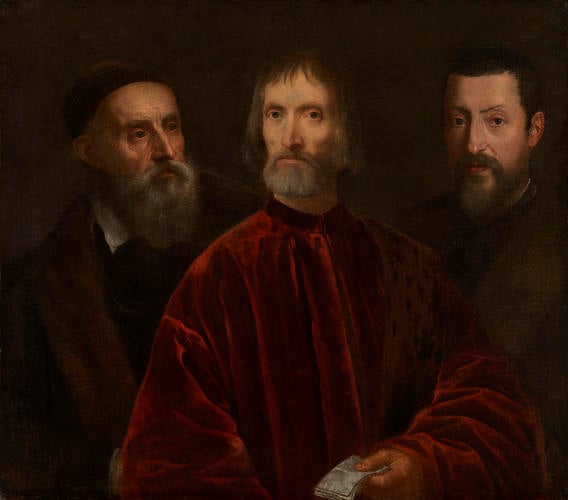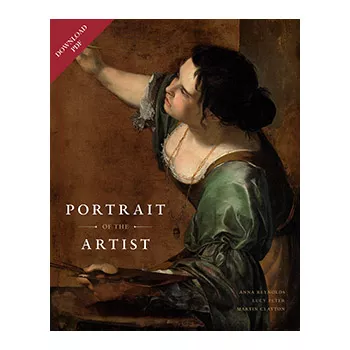Titian and his Friends 1550-60
Oil on canvas | 82.8 x 94.5 cm (support, canvas/panel/stretcher external) | RCIN 402841
-
The inventory of Charles I’s collection describes this painting as showing two figures: ‘The Picture of Tichian himselfe painted by himselfe, and his freind by In a reed velvett venicia senators gowne’. An X-ray taken in 1957 indicated the presence of a third figure, on the right, which was subsequently revealed by cleaning. Several early copies, which depict only two figures, also indicate that the third man was painted over soon after the picture was produced. The three visible heads were painted by different artists and the face of the central figure is of a higher quality than the others, suggesting that the picture was perhaps produced in Titian’s studio. The three figures do not relate to each other in a coherent way and the lighting across them is inconsistent, as noted by Van der Doort in his 1639 inventory, which describes Titian painted ‘upon the wrong light’ (meaning lit from the viewer’s right) and his friend ‘upon the right light’ (lit from the left).
The figure on the left is based on Titian’s self-portrait of c.1550 (Gemäldegalerie, Berlin). He wears a gold chain given to him by Emperor Charles V in 1533, a fur-lined gown and a black nightcap. In 1823 the central figure was identified as Andrea de Franceschi, who, as Grand Chancellor of Venice, occupied one of the most important administrative roles in the city for over twenty years. He wears the scarlet velvet robe of this position. The identity of the third man is not known, although he also appears in another portrait by Titian (Fine Arts Museums of San Francisco) holding a letter inscribed ‘Di Titiano Vecellio singolare amico’. The 1957 X-ray revealed two further figures, a younger man beneath the face in the centre and an elderly bearded man at right angles to the present group.
In 1988 Alan Bennett wrote A Question of Attribution, a fictional one-act play inspired by this painting. Set in the 1960s, it featured Anthony Blunt, Surveyor of The Queen’s Pictures, who in 1979 was publicly exposed as one of five members of the Cambridge Spy Ring, responsible for passing information to the Soviet Union during and after the Second World War. The discovery of the hidden third, fourth and fifth heads in the present painting parallels the exposure of the Cambridge Five. Bennett described his play as an ‘inquiry in which the circumstances are imaginary but the pictures are real’.
Text adapted from Portrait of the Artist, London, 2016Provenance
Acquired by Charles I; recorded in the First Privy Lodging Room at Whitehall in 1639 (no 11); sold from St James's to Jan Baptiste Gaspars 2 April 1650 for £112 (no 234); recovered at the Restoration and listed in the Store at Whitehall in 1666 (no 531)
-
Creator(s)
Acquirer(s)
-
Medium and techniques
Oil on canvas
Measurements
82.8 x 94.5 cm (support, canvas/panel/stretcher external)
114.0 x 129.7 x 8.5 cm (frame, external)
Other number(s)
Alternative title(s)
The artist with Andrea del Franceschi and an unknown man











